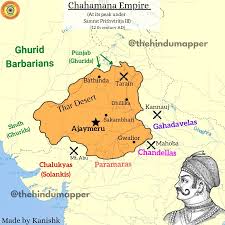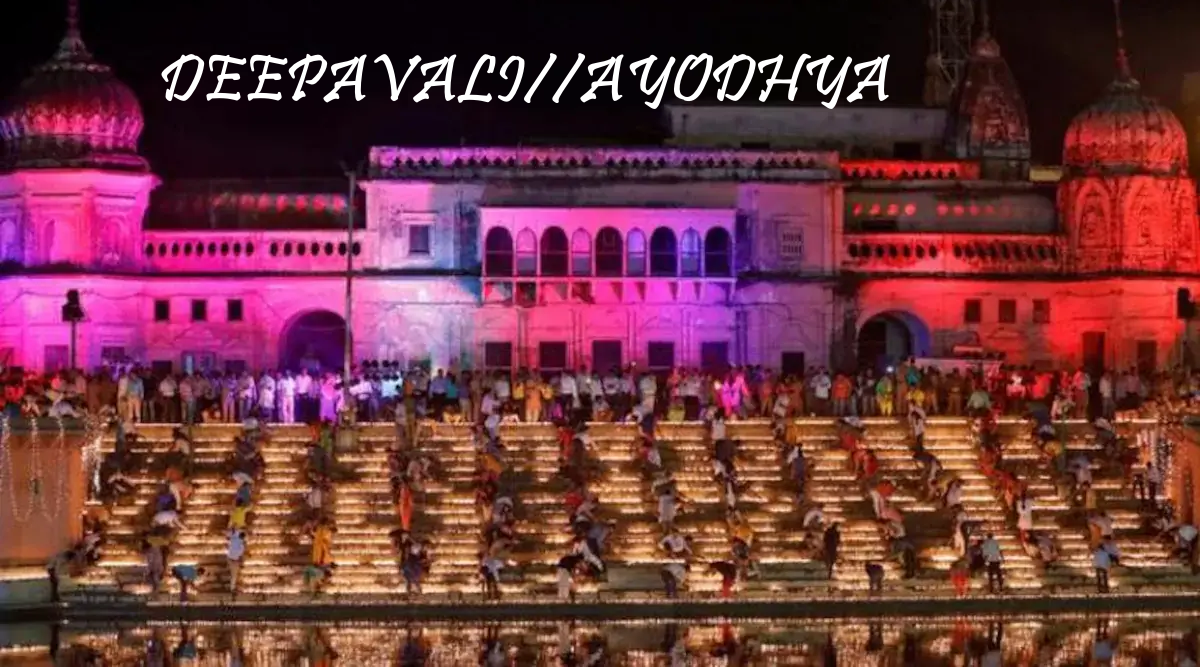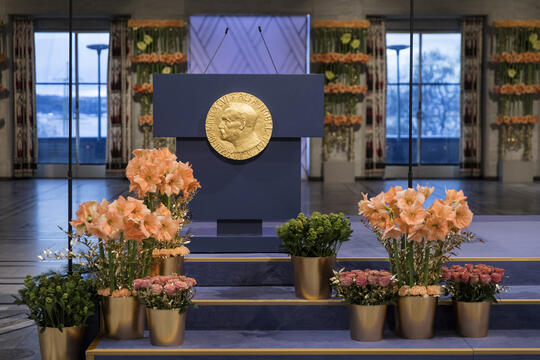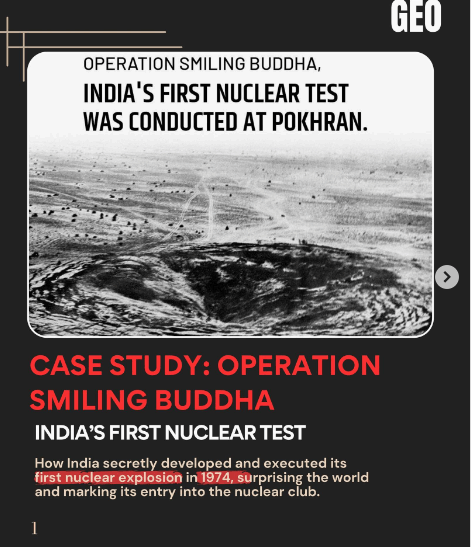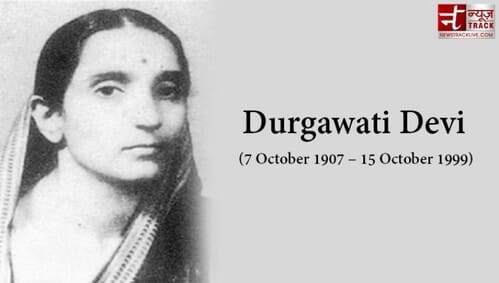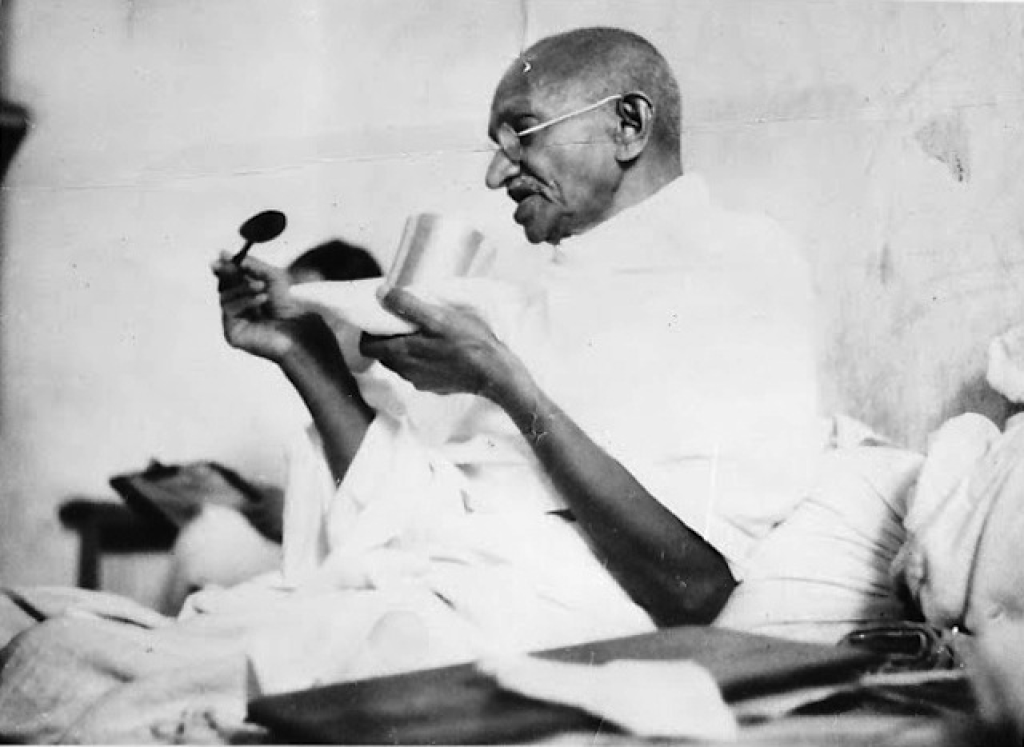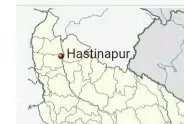“AJEYA MERU”
AJMER OF TODAY
SARASIJ MAJUMDER
While Ajeya Meru alias Ajmer’s history under the Chauhans is central, understanding its regional context provides a broader picture of the area’s ancient past. We will divide in into three parts:
- Ancient Vedic Kingdom:
- Rajput Ancestry:
- Muslim and other Invasions:
Long before the Chauhans, the region surrounding Ajmer was inhabited by various groups mentioned in ancient texts. For example, during the Vedic period (c. 1500–350 BCE), the area was part of the kingdom of Nishadas, one Nishad ruler being Ekalavya, as stated in Mahabharata. Ekalavya attended ‘Rajasuyo’ Jagna, performed by Yudhisthira.
Nishadas were basically ‘HUNTER’ tribe, living in boundary areas inside the forest zone, which are presently called ‘BUFFER ZONES’.
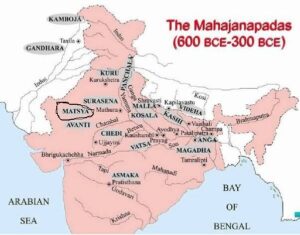
This was a forest area, and was located in the border of MATSYA, (मत्स्य) Kingdom, of Vedic period, ruled by King Virat—where Pandavas spent their Year of INCOGNITO period of exile. Some adjoining area of Ajmer may have been part of Matsya kingdom, whose capital was Biratnagar, presently known as Bairat. There have been significant archaeological excavations made in Bairat, Rajasthan, revealing important artifacts from the Mauryan, Buddhists, and Vedic eras.
Today, many of the artifacts discovered during the excavations are displayed at the Biratnagar Historical Museum near Ganesh Mandir. Visitors can also view the remains of the Buddhist monastery and the Ashokan rock edicts at the excavation sites at Bijak-ki-Pahari.
The ‘MATSYA’ kingdom encompassed parts of present-day Jaipur, Alwar, and Bharatpur districts in Rajasthan. The kingdom existed from roughly 1500 to 350 BCE and the king Virat played a role in the Mahabharata’s War at Kurukshetra.
During the CE 100 – 350 CE period, parts of western and northeastern Rajasthan were ruled by foreign empires such as the Kushans.
Then, it was under the influence of ‘GUPTA’ dynasty. Satraps, and Hunas controlled the area after that.
Ajmer’s glorious history is dominated by its founding in the 7th century CE as “Ajeya Meru” by a Chahamanas (Chauhan) ruler, most likely by Ajayapal Chauhan, who made it their capital. The city served as the heart of the Chauhan dynasty until the late 12th century CE, particularly till under King Prithviraj Chauhan, before falling under the rule of Delhi Sultanate, following his defeat by Mohammed Ghori in 1193 CE, in second battle of Tarain.
AJEYA MERU (Ajmer), by that time, served as the capital of the Chauhan dynasty for five centuries.
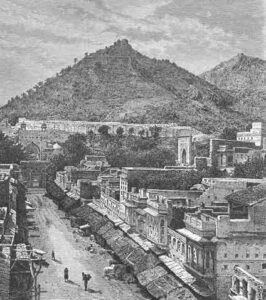
The city’s original Sanskrit name, “Ajeya Meru,” translates to “invincible hill,” is a reference to the Taragarh Hill on which the ancient city may have been located.
The city’s importance is highlighted by its role as the capital of King Prithviraj Chauhan in the late 12th century CE, in various texts available on ‘PRITHVIRAJ’.
Ajmer’s significance reduced dramatically after Prithviraj Chauhan’s defeat.
Other Indigenous Kingdoms: Other powerful ancient kingdoms in the broader region included the Malavas, Yaudheyas, and Gurjaras.
Muslim control of Ajmer began in 1193 CE when it was conquered by Muhammad Ghori and later annexed by the Delhi Sultanate, though the city returned to local rule upon payment of tribute. Later, Ajmer became part of the Mughal Empire under Emperor Akbar in 1556, and it remained a part of Mughal empire, before Rajputs again took back the control during lesser Mughal period. Marathas took control in 1770, leading to its eventual cession to the British in 1818.
A chronology is presented below:
1193 : Following his victory over the Chauhan king, Muhammad Ghori annexed Ajay Meru, marking the first significant Muslim takeover. He installed Govinda Raja, as a vassal king, who joined Ghori against Prithviraj.
1193: Prithviraj’s brother, Hariraja, rebelled against the Ghurid rule and expelled Govinda Raja from Ajay Meru.
1194: Aibak marched on Ajay Meru, defeated Hariraja, and appointed a Muslim governor to take direct control of the city.
1199: By this year, Aibak began constructing the Adhai Din Ka Jhonpra mosque in Ajay Meru, converting a former Saraswati Temple and associated Sanskrit college on the site.
This conquest marked the beginning of Muslim rule in Ajmer, with the city later becoming an important center during the Delhi Sultanate and Mughal periods.
Gradually, in the Muslim usage, ‘Ajay Meru’ got corrupted to ‘AJMER’ due to ARABIC INFLUENCE in which name it is known henceforth, and till today.
Ajmer changed hands between later period of Dehi Sultanate, before Akbar took control.
1556 CE: Mughal Emperor Akbar brought Ajmer under Mughal control, making it the capital of the Ajmer Subah and an important military and religious center.
1770 CE: The city was annexed by the Marathas and remained a site of conflict between the Marathas and Rajputs until 1818.
Cession by Marathas: In 1818, the Marathas ceded Ajmer-Merwara to the British, which facilitated its direct absorption into British territory.
Unlike the surrounding princely states, Ajmer-Merwara was a British territory, directly administered by the British.
Due to its central location within the Rajputana region, Ajmer served as the base for British administration and operations in the area.
A Distinct Province: Ajmer-Merwara was a defined province that included the Ajmer and Merwara districts.
Ajmer was one of the regions affected by the devastating Rajputana famine of 1868-70.
After India’s independence, Ajmer State was merged into the larger state of Rajasthan in 1956.
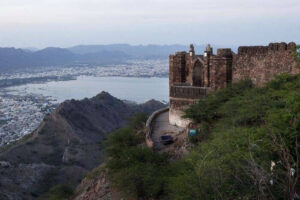
Taragarh Fort, also known as the Star Fort, is a historic fortress in Ajmer, Rajasthan, built on a steep hillside overlooking the city. Originally constructed by King Ajaypal Chauhan around 1113 AD, it became later a significant military and administrative center under various rulers, eventually serving as a British sanatorium. Key features include impressive gateways, a palace complex (Rani Mahal), and the Bhim Burj, offering panoramic city views and a glimpse into Rajasthan’s history.
“Panraksha” (পণরক্ষা), or ” (पणरक्षा )”is a Bengali poem written by Rabindranath Tagore. Durgesh Dumraj, and ‘AJMIR FORT’ are immortalized in that Poem.
I have discussed about this fort in my article on “FORTS OF RAJASTHAN”.
Historical Significance: TARAGARH alias ‘STAR FORT’ alias ‘AJMER GARH’ served as a stronghold for Chauhan rulers, a military center during Mughal rule, and a sanatorium during the British era, reflecting centuries of strategic and architectural evolution.
Saraswati Temple (Adhai Din Ka Jhonpra): This was a magnificent Sanskrit university and temple built by Vigraharaja IV around 1153 CE, but was later converted into a mosque by the Ghurid dynasty.
Vaidhyanath Temple: King Someshwar built this temple, dedicated to Brahma, Vishnu, and Mahesh (Shiva). It is located near Pushkara lake.
Five Kalpavriksha Temples: King Someshwar also built five other temples in Ajmer collectively known as the Five Kalpavriksha Temples. These are destroyed by MUSLIMS.
Budha Pushkar Site: A 2000-year-old wall from the Malava dynasty period was discovered in Budha Pushkar, near Ajmer.
MY SUBMISSION:– In view of all I wrote above—I propose following to the Rajasthan Government:
1.0To rename ‘Ajmer’ as “PRITHVIRAJ NAGAR”—which has historical relevance.
2.0 Bairat shall be renamed as ‘Virat Nagar’.
3.0 Also stop using ‘AJMER FORT’ and refer the same by “TARAGARH” in all texts, history books and official GOI publications and reprints henceforth.
4.0 Re-construct Saraswati Temple with Sanskrit University, to restore history, as close as possible to its original location. The Adhai Din Ka JhonpraMosque shall be closed down.
AJAY MERU (AJMER) is more related to Prithviraj Chouhan than Khaja Moinuddin Chisti’s Tomb / Dargah, known as ‘Ajmer Shariff’. I keep quite on this Sufi Shrine, as a case about this Darga is pending as on date in HC of Rajasthan. However, it may exist where it is, but it shall not be allowed to foment disturbance.
NOTE:– I have sent e-mails to CM/Rajasthan, PMO’s office, and also sent copy by courier attaching this ‘BLOG’.
Sources:
- Mahabharata
- Janapada State in Ancient India (An Old and Rare Book) by Sudama Misra.
- Ajmer: Historical and Descriptiveby judge Har Bilas Sarda–1911
- https://rajras.in/history-of-ajmer/ ( THIS WEB SITE SOMETIMES CAN’T BE REACHED)

